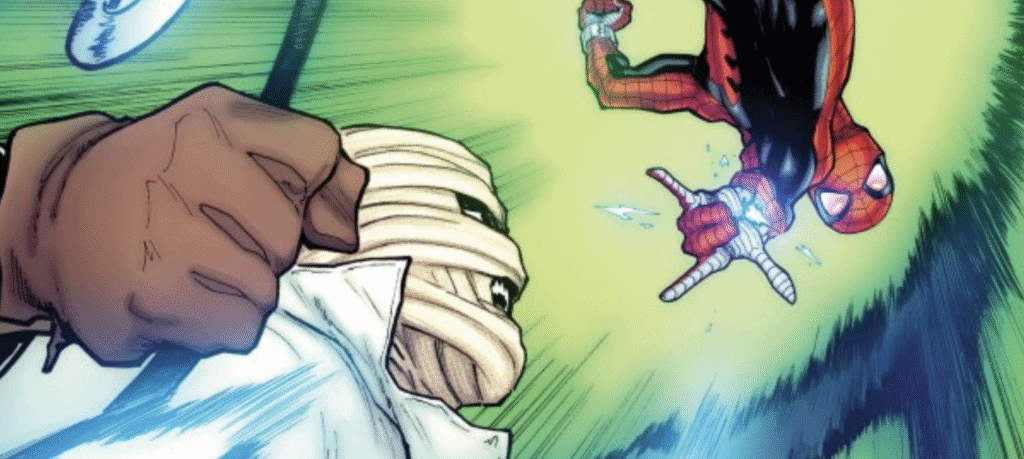The Amazing Spider-Man #16
Recap
THE RESOLUTE SPIDER-SLAYER! Part of being Spider-Man is facing horrific scientifically wondrous SPIDER-SLAYERS! This new Spider-Slayer is particularly dangerous and endangers not only Spider-Man but the new teen hero KINTSUGI! Aunt May drops some wisdom that you won't forget anytime soon!
More Amazing Spider-Man coverage from Comic Watch:
Amazing Spider-Man #13: Your Friendly Galaxy Spider-Man
Amazing Spider-Man #14: Round and Round
Amazing Spider-Man #15: Starman, Waiting in the Webs
Review
I love a good slow burn. Living in a status quo while deeper threads simmer on a stove of creativity has led to some of the most iconic Spider-Man stories ever told, and I respect the current team on The Amazing Spider-Man for attempting to use this pacing strategy in their exploration of both Norman Osborn and Ben Reilly. However, with the recent release of issue #16, that slowness has lost all sense of purpose and has replaced the potential for detailed character building with shallow repetition. That’s not to say this arc has been uninteresting—far from it—but it’s difficult not to notice the rigor of a biweekly release getting in the way of a meatier story.
Not unlike the last chapter of this arc, this issue is focused on chronologically detailing the running mental state of Norman Osborn as he wrestles with finding heroism in himself that doesn’t stem directly from Peter’s influence. Ben continues to face a very similar dilemma as he finds himself trapped in a cycle of living the life of someone he will never get to be. Their parallel journeys of self-discovery have been tackled with a melancholic air that aims to evoke emotional resonance more from a general vibe than any particular narrative hook—which is a bit of a double-edged sword.
For Ben’s side of the story, that really works. Watching Peter’s life glide past his eyes as he is forced to contend with an inability to act on his own accord is rightfully rendered with a quiet sense of sadness. There is no character progression or autonomy for Ben because nothing he has accomplished while impersonating Peter matters to the identity he has struggled to find since his transformation into “Chasm.” The lack of momentum works thematically, the struggle of being content synonymous with a stagnancy that elevates the frustration he exhibits toward the end of this issue.
Norman, however, winds up stalled by the lack of well-paced growth. While every issue has presented him with a new dilemma to face as Spider-Man, each one has left him in the same relative spot he started the arc in, but without the sense that it’s purposeful. There isn’t a point to the arrested development he’s been stuck with outside of needing the arc to span the same length as the core Peter story. This issue specifically sees him go head-to-head with Tombstone and a new villain, but it winds up touching on the same beats we’ve already hit with Norman. Yes, it may sport new tricks, but it’s the same dog we’ve been circling around since the character’s villain status was reversed. We need more time with overarching plots that are thematically focused on something different, while utilizing Norman’s road to self-realization as an undercurrent to tie the whole thing together.
Peppered in the space between these two plots are some interesting character beats with Aunt May that color the side-cast complexity of this title with a bit more purpose than they’ve been granted in a hot minute. Kelly specifically gets to flex a critical understanding of May’s character against the likes of Jonah. While one may know that Peter is Spider-Man, it’s May who understands the human beneath the mask and provides a thematically relevant excuse for her not drowning in worry over her nephew’s recent distance.
There isn’t much to add at the end here about the art. John Romita Jr. is back to do his thing with Tombstone, and not much else. I won’t beat a dead horse on whether or not his work is still up to par for a title of this size, so instead I’ll highlight a particular moment in this issue that really stood out to me. There is a conversation between Norman and Maria that is focused purely on Norman Osborn, the human being—not a perfect one, but one whose lowest of lows provide him with a unique ability to empathize and relate to people whose character is ten times his own. It shows him seeking a greater connection to humanity as we seem to be settling into a space for him that is no longer obsessed with justifying a decision from five years ago. Great stuff there, and the defining reason I’m still loving what Kelly is attempting here, even if his stylistic focus on vibes is undercutting the depth of potential for this arc.
Final Thoughts
The Amazing Spider-Man #16 spins a repetitive web that I can't help but still find a reason to enjoy, regardless of the lethargic pacing that is holding back an arc choked with potential.
The Amazing Spider-Man #16: The Osborn Identity
- Writing - 6.5/106.5/10
- Storyline - 7/107/10
- Art - 6.5/106.5/10
- Color - 7.5/107.5/10
- Cover Art - 6.5/106.5/10
